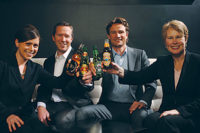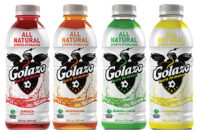Marketing through the generations
Identifying the wants and needs of age groups



Originally designed to appeal to young men, Dos Equis’ “The Most Interesting Man in the World” campaign has become an example of ageless marketing because men of all ages can aspire to be like the character.







Once a product makes it to the store shelf, brand appeal and package design can’t always carry it to success. That’s when companies turn to marketing. But when the market is filled with millions of individuals of various ages with different backgrounds, marketing can turn into a puzzle. Marketers are tasked with not only determining their message, but also the product’s audience and the best ways to reach them. If all of these pieces don’t fit, the brand’s target audience might not be enticed to purchase the product.
The two largest generations of consumers currently are baby boomers and millennials, says Ty Law, U.S. research analyst at Euromonitor International, Chicago. According to the U.S. Census Bureau, members of the baby boomer generation were born between 1946 and 1964. Millennials were born between 1977 and 2000, according to Kansas City, Mo.-based marketing firm Barkley. Sandwiched between these two generations is Generation X, which includes people born between 1965 and 1976, the U.S. Census Bureau reports.
Major events, such as the Vietnam War, the introduction of the Internet, Sept. 11 and the recent recession, have impacted each of these generations in varying ways during the years. In addition, life experiences unique to each consumer have helped to form their current purchasing behaviors.
Millennials
“Since the millennial generation is larger than the baby boomers and three times bigger than Generation X, marketers’ understanding of millennials’ needs, tastes and behaviors will clearly shape current and future business decisions,” said Jeff Fromm, senior vice president of Barkley, in a statement.
The marketing firm recently released “American Millennials: Deciphering the Enigma Generation,” a research study conducted in partnership with the Service Management Group and The Boston Consulting Group. The study was based on a survey of more than 5,000 respondents and 3.9 million data points, comparing the digital and social media habits of American millennials between the ages of 16 and 24 and non-millennials. According to the study, millennials seek value-priced products so that they can spend more money on other products that reflect their style or personality.
Beverages in particular play an important role in the image category, says Brad Hanna, senior vice president and group account leader at Barkley. Sodas, energy drinks and juices that are sold in the produce department, such as Odwalla and Naked, have done a great job of creating brand personalities to present the distinct image that millennials want to project, he says.
Millennials also are more committed to health than non-millennials, but not on a consistent basis. They like to eat healthier during the week, but on the weekends they indulge, Hanna says.
“It’s harder to put the millennials into one distinct profile,” Hanna says. “They’re very healthy, but they’re very adventuresome, and that really means that brands have opportunities to capture that part of millennials when they’re in those mindsets. I think that’s very different than how we market today. We tend to really look at our consumers today as a single mindset. We’re going to have to understand the different mindsets that [millennials] transition in and out of in their daily lives.”
One key element to keep in mind when marketing to millennials is technology. Barkley’s study found that millennials use smartphones or tablets when making decisions about products or physically shopping for products almost twice as often as non-millennials. Brands are capitalizing on this fact and creating digital connections with their consumers versus marketing to them, Hanna says. Marketers can create a conversation through quick response (QR) codes on packaging, interactive websites and social media.
For instance, Hydrive Energy, Rye, N.Y., launched QR codes on its Extra Energy and Decaf enhanced water energy drink varieties this summer. When scanned, the codes take consumers to a mobile site offering a constantly changing array of fitness trivia, contests, free prizes and product information, the company says.
However, in the social media realm, brands can’t always control the content.
“Social media is basically the new word-of-mouth advertising,” Euromonitor’s Law says. “[Millennials are] very social media driven. If they like something, everybody will know about it. If they don’t like something, that news too will travel fast over social media. People say it’s the best way to advertise because it’s highly trustworthy. It’s not necessarily an ad telling you, but it’s somebody you know telling you something positive or negative about a product.”
Millennials are more likely than non-millennials to rate products on the Web, check out brands on social media sites and support their favorite brands, Hanna says. And when a brand participates in social media, consumers like that brand more, he adds.
Millennials also are more influenced by cause-focused marketing campaigns and events than they are by direct marketing. For example, in 2001, Red Bull created a freestyle motocross (FMX) tour called X-Fighters, which features some of the world’s best FMX riders. Events like X-Fighters appeal to millennials more than direct advertising, Law says.
Baby boomers
Baby boomers, on the other hand, are influenced by all types of advertising.
“Boomers were the first generation raised in front of a TV, so TV is definitely their medium, but they’re also the last generation that consumes all media,” says Matt Thornhill, founder and president of the Boomer Project, a marketing research and consulting firm based in Richmond, Va. They listen to the radio, watch TV, read newspapers and magazines, and surf the Internet, making them the easiest generation to reach, he says.
However, a misconception about this generation exists when it comes to brand loyalty.
“There is a belief that at one point, older workers were considered not such a hot sector for marketers because they had already adopted loyalties in products, so it was difficult to get them to change and try new products,” says Jim Gilmartin, president of Coming of Age Inc., an advertising, marketing and training firm specializing in baby boomers and older consumers based in Wheaton, Ill. “It’s a myth. Research confirms that older customers will change buying habits as quickly as others.”
In the beverage industry, which launches new brands and innovations constantly, baby boomers are not that brand loyal, Thornhill says. They’re going to buy new products that deliver for them. However, this misconception leads many marketers to focus their attention on millennials, ignoring the baby boomer generation, he says.
“What we try to help people understand is to figure out how to get more people of all ages to consume your beverage; don’t make it just about the young,” he says. “There’s almost a new rule in marketing that if you can figure out how to appeal to an older consumer, you can also attract a younger consumer.” Thornhill calls this type of advertising “ageless marketing.”
An example of this type of marketing is Dos Equis beer’s “The Most Interesting Man in the World” campaign. Dos Equis, a brand of Heineken International, Amsterdam, first launched the campaign in 2007 aimed at young men of legal drinking age, Thornhill says. The ad features an older actor who looks back at his “interesting” life. Men of every age can aspire to be the most interesting man in the world, Thornhill says.
Storytelling works well when marketing to older consumers, Gilmartin says. Marketers should integrate their data into an emotional matrix to satisfy a customer’s need and gauge the potential emotional and experiential quality of the relationship before talking about a product’s benefits and features, he suggests.
Energy drinks and shots might be considered a category that appeals only to millennials, but that’s only partially correct. Millennials are the prime market for energy drinks, however, energy shots are being marketed more often toward baby boomers, Euromonitor’s Law says.
One of the main interests of baby boomers is maintaining their vitality, Thornhill says. Beverages such as Ensure and 5-Hour Energy fulfill this need, as do fortified and functional drinks. However, marketers can’t simply state the benefits of their products to entice baby boomers; they need to create an emotional connection first, says Coming of Age’s Gilmartin.
“When selling to [older consumers], focusing on product features and benefits often results in a losing strategy, especially early on in the process,” he says. “Research has shown that customers’ final decisions are not the direct product of the reasoning process. In fact, emotions drive older customers in their purchase decisions. The reasoning process will confirm their decision, but it doesn’t start there.”
Although some categories appeal across generations, other beverages specifically target baby boomers. Last year, Abbott Park, Ill.-based Abbott launched Ensure Muscle Health and Ensure Clinical Strength nutrition shakes in response to the growing needs of America’s aging baby boomer population, the company says. Clinical research shows that starting at age 40, people can start to lose 8 percent of muscle mass per decade, Abbott said in a statement. Two servings of Ensure Muscle Health or Ensure Clinical Strength each day help to protect muscle cells, preserve muscle tissue, promote muscle growth, support digestive tract health and support the immune system, it adds.
Generation X
Because Generation X is between two of the largest generations in America, marketers often include Generation X in their campaigns directed toward millennials or baby boomers, according to Mintel’s April 2011 “Marketing to Gen X – U.S.” report. However, as Generation X moves into its prime earning years, they will begin to eclipse baby boomers in per consumer unit spending, the report says. Marketers should capitalize on this change by creating marketing campaigns more focused on Generation X, it adds.
According to a July 2010 New York Times article, Purchase, N.Y.-based PepsiCo’s Pepsi Max brand tends to be more popular with Generation X, Mintel says. Pepsi Max is a zero-calorie soft drink designed to capture the flavor of a regular cola, PepsiCo says. The New York Times article states that about 60 percent of Pepsi Max drinkers are men. The brand’s packaging, TV advertising and social media use demonstrate the ways it appeals to the men of Generation X.
According to Mintel, the brand’s target demographic is men aged 20 to 50, which is mainly Generation X but dips a little bit into the millennial generation. The product is available in cans and two types of plastic bottles. The first bottle reflects the same structure as PepsiCo’s other soft drinks. However, the other plastic bottle resembles a beer bottle, which might appeal to male consumers looking for a beer alternative, the Mintel report notes.
Featuring the taglines, “Too much taste to be called a zero” and “Zero calories, maximum Pepsi taste,” Pepsi Max commercials use humor to convey their message. One Pepsi Max commercial is based on the friendly competition between Pepsi Max and Coke Zero delivery men. Mintel says the characters are portrayed by actors who appear to be in the Generation X age range.
“In some ways, the competition resembles those that often occur around Christmas in neighborhoods around the nation,” the Mintel report says. “Like the men who adorn their houses with elaborate lighting during the holidays in an attempt to outdo their neighbor, these men compete for the best diet cola display.
“The tagline ‘Too much taste to be called a zero’ is interesting for the fact that it focuses on taste rather than potential weight loss benefits,” Mintel continues. “This message appeals to men who want low-calorie drinks but don’t want to buy ‘diet’ products.”
Another Pepsi Max ad targets young Generation Xers and older millennials, and focuses on the different ways men and women approach dating. At the end of the commercial, a link to the brand’s Facebook page appears, supporting its broad social media marketing strategy, the Mintel report states. As of Sept. 9, the Pepsi Max Facebook account had nearly 748,100 “likes” and its Twitter account had more than 15,350 followers.
Pepsi Max also has a strong following on YouTube, where more than 20 Pepsi Max videos were posted as of Sept. 9. The most popular video on the channel at that time was “Love Hurts,” which tells a story about a couple in their late 30s or early 40s. By early September, the video received more than 920,500 views. In a humorous way, the woman exercises a great deal of control over her partner’s diet, enabling Generation Xers to relate to the constraints of relationships and the frustrations of maintaining a healthy diet, the Mintel report says.
In fact, half of Generation Xers are consuming healthier foods and beverages in order to lose weight, reduce their fat intake or maintain healthy cholesterol. As the generation moves into their 40s, the demand for better-for-you beverages is increasing among this group, Mintel says.
When Generation X consumers are in a grocery store shopping for products, however, most of them overlook in-store advertising. This data suggests that Generation Xers shop with a list and remain fairly focused on purchasing only what’s on that list instead of exploring the store, Mintel reports. The type of advertising that does catch their eye, however, is product placement and outdoor advertising.
Generation Xers spend nearly 12 hours a week watching TV, according to Mintel’s report. It also found that 52 percent of Generation X consumers feel product placement in TV shows and movies is acceptable, and 44 percent report noticing products on the sets of TV shows or movies they watch. Twenty-five percent agree that seeing a product or brand they use on TV makes the show seem more realistic to them, and 24 percent remember products that they saw characters using in TV shows.
Another way to reach Generation X consumers is through outdoor advertising. Forty-nine percent of Generation Xers notice large billboards, and Generation Xers are more likely than younger or older American adults to notice ads on bus shelters or benches, taxis, and sports arenas, the Mintel report states.
Each generation has its own set of preferences and reasons behind each of them. By studying the way each of these generations thinks and acts, marketers can determine the best way to get their products in front of their target audience. Like fitting the last puzzle piece into the final spot, marketing is successful not only when consumers buy the product, but when they interact and connect with the commercial, advertisement or social media platform being used. BI
| Top 5 tips for marketing to baby boomers |
|
1. Be honest and authentic. Baby boomers have lived long enough to know hype when they see it. Products must perform as advertised. 2. Don’t portray baby boomers as older than they feel. Consider “younger” images when selling products to older consumers. “Older” images might cause older consumers not to resonate with your message. 3. Appeal to their core values and motivators. Just like other groups, older consumers identify with others who reflect their core values, lifestyle and stage of life. For example, products that celebrate the vitality, energy and individuality of the purchaser are more tempting than those that do not. 4. Have fun. Anything you can do to get a “wow” reaction will work for you. The experience must be social and sensory, as well as quick, easy and convenient. 5. Give them value. Older consumers do research on products before they spend their money. *Source: Jim Gilmartin, president of Coming of Age Inc. |
Looking for a reprint of this article?
From high-res PDFs to custom plaques, order your copy today!












